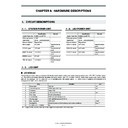Sharp PN-V602 (serv.man7) Service Manual ▷ View online
CHAPTER 8. HARDWARE DESCRIPTIONS
PN-V602 HARDWARE DESCRIPTIONS
8 – 6
1 - 9. PWB OF CONTROL KIT
■ I/O SIGNAL
■ MAIN COMPLETE PARTS AND FUNCTION
Specifications
Connector used
Control Signal
Control Kit control input/output terminal
3pin connector (The harness for connecting I/F board is connected on the
PWB.)
PWB.)
Reference
Part name
Part function
IC103
R5F21324CNSP
Micro computer (micom) Communicate with the micom on the I/F board, and
send the illumination sensor ADC value and remote control data.
IC105
GP1USC31XP
Photoreceiver for remote controller.
Receive the signal from the remote controller.
IC106
GA1A2S100LY
Illumination sensor.
Receive the light around the Control Kit (PN-ZR01).
IC101
TC7SH14FU
Schmitt trigger inverter
IC102
PQ1X301M2ZPH
Regulator.
Generate the ADC reference voltage of micom and illumination sensor.
CHAPTER 8. HARDWARE DESCRIPTIONS
PN-V602 HARDWARE DESCRIPTIONS
8 – 7
2. LOCAL DIMMING FUNCTION
This model employs the local dimming system which controls the brightness individually by dividing the LED’s into 16 x 12 lighting areas for saving
energy and improving the contrast. The difference from the conventional models is as explained below.
In the conventional systems as shown in Fig. 2-2a, video signals are transmitted in the path of the main PWB
3 LCD-TCON PWB 3 LED. The back-
light is turned ON/OFF by the main PWB.
In the local dimming system as shown in Fig. 2-2b, video signals are transmitted to the LED-TCON PWB, then divided into the two paths; one for con-
trol of LED lighting according images, and the other for displaying images. The LED-TCON controls the LED driver, and controls the brightness of
trol of LED lighting according images, and the other for displaying images. The LED-TCON controls the LED driver, and controls the brightness of
each area deliberately, lighting LED's at the proper brightness. At the same time, the corrected images according to the LED lighting are transmitted
to the LCD-TCON. The both operations work together to display proper images. The LED-TCON PWB and the LED driver PWB are the great factors
of the improvement in this model.
of the improvement in this model.
LCD-TCON
LED power
[+LED driver]
[+LED driver]
LCD
LED
Main PWB
Fig. 2-2a. System in the past
LCD-
TCON
LCD
LED
LED-
TCON
Fig. 2-2b. Local dimming system
Main PWB
[Panel side]
[Backlight side]
LED
driver
CHAPTER 8. HARDWARE DESCRIPTIONS
PN-V602 HARDWARE DESCRIPTIONS
8 – 8
LCD data
Error notification
LCD-
TCON
LED-
TCON
PWB
PWB
LCD data
LCD panel
LED backlight
LED data
LED data
Area control technology
Lights the necessary areas
at the proper brightness.
at the proper brightness.
Main I/F
PWB
Control signal
LED image (LED backlight)
LCD module
Output image (LED module)
LCD image (LED panel)
Input image
Image data
Image data
LED
driver
PWB
CHAPTER 8. HARDWARE DESCRIPTIONS
PN-V602 HARDWARE DESCRIPTIONS
8 – 9
3. FAN
3 - 1. FAN CONTROL
When the fan rotation speed is set to “Auto,” the fan rotation speed (RPM) changes automatically in accordance with the temperature of Sensor 1.
(Figure.X1)
(Figure.X1)
However, as the minimum RPM
*1
is specified, the fan doesn’t stop even at the temperature to stop the rotation in some cases.
See the Table.X1 below for the temperature obtained by each Sensor, the fan rotation speed and the threshold temp. for temperature watch.
*
1
The minimum RPM differs according to the current “brightness” setting, so the fan won’t stop depending on the brightness of screen.
*
2
The power fan is fixed-controlled. (Constant operation at about 1260rpm when the fan for the duct is operating)
FIGURE.X1 TEMPERATURE, FAN ROTATION SPEED (RPM) AND STATUS CHANGE BY TEMP.WATCH (FAN ROTATION SPEED SET TO "AUTO")
TABLE.X1 TEMPERATURE, FAN CONTROL AND THRESHOLD FOR TEMPERATURE ABNORMALITY
*
1
The LED flashes in red-green, the “Monitor Temperature” alert is displayed in the screen, and the brightness goes down to “Bright Level 5”.
(In the default settings, “Monitor Temperature” is not displayed.)
When it is in the status of high temp abnormality, if the temperature has lowered to 5°C or below, or the power is turned off and on by the button
When it is in the status of high temp abnormality, if the temperature has lowered to 5°C or below, or the power is turned off and on by the button
of Display Unit or the remote control, the status of high temp abnormality is cleared.
*
After power-on, the fan starts from 0 (rpm) and then the RPM is determined based on the temperature immediately after the power-on.
Display
installation/
layout
Temp. Sensor
Temp.to
lower RPM
Temp.to
raise RPM
Temp.to
lower RPM
Temp.to
raise RPM
Temp.
determined as
high-temp
*1
Temp.
for power
shut-off due to
high temp
Horizontal
installation
Sensor 1
38°C
43°C
49°C
54°C
61°C
66°C
Sensor 2
---
---
---
---
60°C
65°C
Sensor 3
---
---
---
---
60°C
65°C
Sensor 4
---
---
---
---
60°C
65°C
Sensor 5
---
---
---
---
62°C
67°C
Sensor 6
---
---
---
---
62°C
67°C
Vertical
installation
Sensor 1
42°C
47°C
50°C
55°C
62°C
67°C
Sensor 2
---
---
---
---
62°C
67°C
Sensor 3
---
---
---
---
62°C
67°C
Sensor 4
---
---
---
---
62°C
67°C
Sensor 5
---
---
---
---
62°C
67°C
Sensor 6
---
---
---
---
62°C
67°C
0
1200
3400
Fan Rotation
Speed
㩿rpm㪀
Temp.
to lower RPM
Temp.
to raise RPM
Temp.
to lower RPM
Temp.
to raise RPM
High temperature
abnormality
Temp. to
shut off the power
LED flashes in red-green,
"MonitorTemp" is
displayed, and the
brightnessgoes down.
"MonitorTemp" is
displayed, and the
brightnessgoes down.
It shifts to
thestandby
statusfor safety.
thestandby
statusfor safety.
Click on the first or last page to see other PN-V602 (serv.man7) service manuals if exist.

